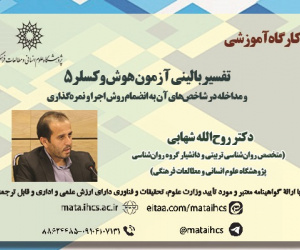طراحی مدل اجرای خط مشی بانکداری دیجیتال مبتنی بر به کارگیری کلان داده ها در بانک های دولتی ایران (مقاله علمی وزارت علوم)
درجه علمی: نشریه علمی (وزارت علوم)
آرشیو
چکیده
هدف: این پژوهش در تلاش است تا با عنایت به فقدان الگوی اجرای خط مشی بانکداری دیجیتال، به ویژه در بانک های ایران، ضمن بررسی ابعاد اجرای خط مشی این مدل از بانکداری، به ارائه الگوی اجرای هرچه بهتر این خط مشی با تأکید بر به کارگیری ابزار فناوری کلان داده بپردازد که کمتر به آن توجه شده است و در عین حال، در دستیابی به اهداف و پیاده سازی بهینه بانکداری دیجیتال تأثیر بسزایی دارد. روش: پژوهش حاضر از نوع کیفی و پست مدرن با رویکرد استقرایی است و از استراتژی نظریه داده بنیاد با رویکرد ظاهر شونده یا کلاسیک (گلیزری) بهره برده است. از آنجا که ارائه یک نظریه مبنایی، مستلزم گردآوری داده های متنی مصاحبه ای عمیق است، به منظور شناسایی مفهوم ها، مقوله ها و مؤلفه های مدل اجرای بانکداری دیجیتال با به کارگیری فناوری کلان داده ها، مصاحبه های نیمه ساختاریافته با خبرگان بانکی و حوزه های دیجیتال مالی انجام گرفت. مشارکت کنندگان ۱۸ نفر از خبرگان در دسترس صنعت بانکداری بود و نمونه گیری به صورت قضاوتی هدفمند و تا حد اشباع نظری صورت گرفت. داده های پژوهش با استفاده از کدگذاری های باز، محوری و انتخابی تحلیل شد و بر اساس مقوله ها و مفهوم های استخراج شده، در نهایت الگوی پژوهش به دست آمد. یافته ها: الگوی به دست آمده مشتمل بر ۱۶ مضمون اصلی مدیریت کلان داده هاست که عبارت اند از: حاکمیت داده (شامل: جمع آوری داده ها، پالایش داده ها، طراحی و مدل سازی داده، امنیت داده ها)، رگولاتوری داده ها، منابع متنوع کسب داده، اعتماد به تحلیل کلان داده ها، دانش موجود، اکوسیستم نظام بانکی، چابکی سازمانی، ابزارهای تحلیل کلان داده ها، تدوین سناریوها (کاربرد عملی داده ها)، ساختار اجرایی، بهبود کسب وکار بانک ها، مشتری مداری، شفافیت، زیرساخت های فناورانه و فرهنگ غالب که در قالب ۶ بُعدِ الگوی ۶ سی گلیزر و یک بُعد مقوله اصلی یا محوری به صورت مدل نهایی تحقیق نظم یافتند. با توجه به مدل استخراج شده برای مدیریت کلان داده ها، محور اصلی و ۱۵ مضمون دیگر مرکز ثقل الگو است که در دسته بندی خانواده پیوندها نمایان و ارتباط بین آن ها تبیین شد. نتیجه گیری: یافته ها از بی توجهی و به کارنگرفتن فناوری کلان داده ها در بانک ها حکایت می کند. با وجود منابع سرشار اطلاعاتی و داده ها در بانک های دولتی، این سرمایه ارزشمند در حال هدر رفتن است، در صورتی که با بهره گیری مناسب از کلان داده ها، می توان ضمن ارتقا و بهبود بستر مشتری مداری که از اهداف اصلی بانکداری دیجیتال است، مزیت رقابتی لازم را برای بقا و حفظ جایگاه در بین بازیگران جدید و قدیم عرصه بانکداری ایجاد کرد و بدین ترتیب، اجرای خط مشی بانکداری دیجیتال را بهبود بخشید. الگوی به دست آمده تلفیقی از عوامل برآمده از رویکرد فناورانه، فرهنگ سازمانی و بهره ورانه در بانکداری بانک های دولتی، جهت به کارگیری کلان داده هاست که برای تحقق بهتر اجرای بانکداری دیجیتال، می بایست در بانک های دولتی کشور بر این عوامل تأکید شود. نتایج پژوهش نشان می دهد که مدیریت کلان داده ها، حاکمیت داده (شامل: جمع آوری داده ها، پالایش داده ها، طراحی و مدل سازی داده، امنیت داده ها)، رگولاتوری داده ها، منابع متنوع کسب داده، اعتماد به تحلیل کلان داده ها، دانش موجود، اکوسیستم نظام بانکی، چابکی سازمانی، ابزارهای تحلیل کلان داده ها، تدوین سناریوها (کاربرد عملی داده ها)، ساختار اجرایی، بهبود کسب وکار بانک ها، مشتری مداری، شفافیت، زیرساخت های فناورانه و فرهنگ غالب، مقوله ها و عواملی هستند که بانک های دولتی کشور برای به کارگیری کلان داده ها در ساختارهای خود، باید به دقت آن ها را بررسی و رعایت کنند.Designing a Model for Implementing Digital Banking Policy Based on Using Big Data in Iranian Banking Industry
Objective
In the current digital era, the immense challenges posed by technological advancements have driven significant developments, including the emergence of digital banking policies. For banks to survive and maintain their competitive edge among both new entrants and established competitors, it is essential to correctly implement digital banking strategies. This requires not only appropriate structural changes but also careful planning, the adoption of new business methods, and the use of innovative and technological tools, such as big data, to achieve strategic goals. On a broader scale, these efforts contribute to the realization of a smart economy. This research addresses the gap in existing literature regarding the lack of a digital banking policy implementation model, particularly within Iranian banks. It seeks to develop an optimal model for implementing such policies, with a special focus on the dimensions of policy implementation specific to digital banking. The research emphasizes the pivotal role of big data technology, which has received limited attention but has a significant impact on achieving the goals and ensuring the optimal implementation of digital banking.
Methods
This research falls within the realm of qualitative and postmodern studies, adopting an inductive approach. The research strategy employed is "Grounded Theory," specifically the emerging or classical Glaserian approach. Given that developing a foundational theory necessitates the collection of in-depth interview and textual data, the study aimed to identify the concepts, categories, and components of a digital banking implementation model leveraging big data technology. To this end, semi-structured interviews were conducted with experts in the fields of banking and financial technology. The study involved 15 accessible experts from the banking industry, selected through purposive judgment sampling. Interviews continued until theoretical saturation was reached, ensuring that the data collected was comprehensive and insightful. The research data was analyzed through a process of open, axial, and selective coding, which allowed for the extraction and categorization of key concepts. Ultimately, these efforts led to the emergence of a robust research model.
Results
The resulting model identifies 15 main themes, including Big Data Management, Data Governance (encompassing Data Collection, Data Refinement, Data Design and Modeling, Data Security), Data Regulation, Various Sources of Data Acquisition, Trust in Big Data Analysis, the Banking System Ecosystem, Organizational Agility, Big Data Analysis Tools, Scenario Development (practical application of data), Executive Structure, Improvement of Banks' Business, Customer Orientation, Transparency, Technological Infrastructure, and Dominant Culture. These themes were organized into six dimensions based on Glaser's 6C model, with an overarching or central category dimension forming the core of the final research model. According to this model, Big Data Management serves as the main axis around which 13 other themes revolve, acting as the model's center of gravity. This relationship is explained within the category of linkages, highlighting how these components interconnect.
Conclusion
The findings underscore a significant gap in the attention and application of big data technology within banks. Despite the availability of rich information and data resources in state banks, this valuable capital remains underutilized. Proper utilization of big data could create a necessary competitive advantage, enabling banks to survive and thrive amidst competition from both new and old players in the banking sector. Moreover, leveraging big data can enhance and improve customer-oriented platforms, a primary goal of digital banking, thereby facilitating better implementation of digital banking policies. The model developed through this research illustrates the integration of technological, organizational, and innovative cultural factors within state banks, all aimed at effectively utilizing big data. To optimize digital banking implementation, these factors must be prioritized within the structures of the country's state banks. The results demonstrate that Big Data Management, along with associated governance, regulatory practices, and infrastructural considerations, are crucial categories that must be meticulously observed and integrated into the operational frameworks of state banks to fully harness the potential of big data.








